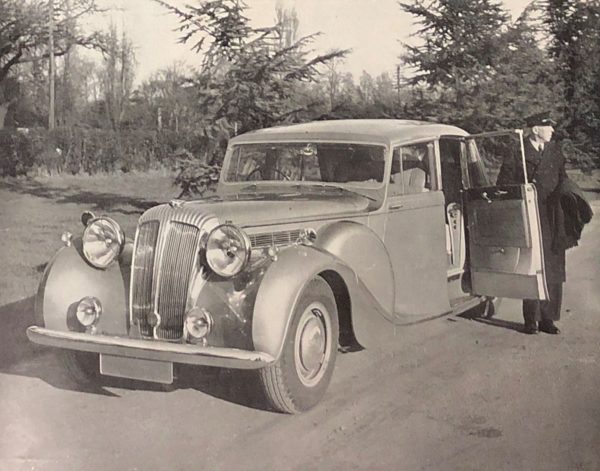
The Motor, in December 1947, made no bones about it:
The post-war Straight Eight Daimler is an entirely new design and is a car of such striking performance and qualities that one searches almost in vain, for the appropriate adjective. Possibly ’fabulous’ is the most embracing term for a car that is considerably the most expensive in the world, has the largest wheelbase and biggest body space of any European car, has all the qualities of silence and dignity of which Daimler is a synonym with speed acceleration and road holding which would evoke praise in a sports model.
The straight-eight D 36 was a development of the postwar DE 27. That car made good use of the 4-litre (4,095cc) six-cylinder engine that had proved its worth in wartime armoured cars. The DE 27 was considered to be a medium type in the Daimler range – but was at its introduction in 1946 one of the largest production cars in the world. The DE 27 was also considered acceptable to the highest in the land: chassis 51101 was delivered to Queen Mary in 1947, and on 2nd February 1948 chassis 51040 was presented to HRH Princess Elizabeth. It carried the registration HRH 1. Both cars were Hooper-bodied limousines.
The chassis of the DE 36 was almost identical to that of the DE 27, but even longer, by 9 inches. This enabled the finest coachwork to be fitted to the DE 36 during its seven year production run from 1946 to 1953, the standard designs being from Hooper, Windovers and Freestone & Webb and suitable for mounting on either chassis. The giant Lucas P100 headlamps could occasionally look uncomfortably oversize, even on Rolls-Royces – but the DE 36 carried them beautifully (although some coachwork used smaller, conventional faired-in headlamps between or even within the wings).
The DE 36 straight-eight engine had the same cylinder dimensions as the DE27, the extra cylinders increasing capacity to 5,460cc and power output from 110 to 150bhp. Transmission was through the traditional and highly effective Wilson preselector gearbox with fluid flywheel. But power without a well-designed chassis would not have given the ‘sporting’ character of this big car, so appreciated by the motoring press. Centre of gravity was kept low by inclining the engine down by five degrees, by further dropping the angle of the propeller shaft and by the use of a hypoid differential (where the drive pinion was lower than the centre-line of the crown wheel). As a result, even with a fully laden car, the universal joints were still running at an angle – a quirk that in fact extended their life, since the bearings were not loaded at one spot as they would be if they ran exactly in line for most of their life. Controllability was helped by unconventional steering geometry: instead of normal inclination of the king-pins to provide castor angle, the hub centres lay just behind the king-pin centres. The Motor considered this to be a sure sign that the car’s designers were prioritising good handling even on this gargantuan limousine.
Our Snapshot shows Daimler’s own show car with Hooper coachwork, and many distinguished customers bought Hooper-bodied D 36 cars, from the president of Czechoslovakia to Lord Beaverbrook – with four being delivered to King George VI and one being kept as ‘Royal Stock’ in the days when the Royal family still maintained loyalty to Daimler over the undoubted charms of Rolls-Royce.
These straight-eight Daimlers also formed the chassis for some of the famous – or infamous – ‘Docker Daimlers’ built for the company’s chairman and his wife. Such a fine and commodious chassis clearly encouraged the Dockers to match it to the most exotic of creations. But that is another story.
Picture courtesy of the Richard Roberts Archive







Leave a Comment